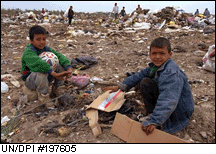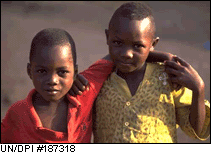|
|
International Banks and the First Debt Crisis: Latin America
 |
|
After the horrors of the Depression and the Second World War, Allied nations recognized the need for greater coordination of the future international economy. In 1944, a conference of 44 nations in Bretton Woods, New Hampshire, created two new instruments for international financial and monetary cooperation, the World Bank and the International Monetary Fund. The following year, these institutions set up shop in Washington, D.C. |
| |
For twenty-five years, the world's new 'Bretton Woods economy' functioned rather smoothly. Gold was the base for the world monetary system, with international currencies maintained at fixed rates relative to the US dollar. With a strong anchor for world currencies, governments were motivated to keep financial discipline.
The early 1970s brought a sea change. The Great Society programs and the Vietnam War had driven America's budget deficit deep into the red. At the same time, many of the world's former colonial nations, having industrialized gradually through the 1950s and 60s, were manufacturing a substantial volume of products for export. International speculators began pulling capital out of the United States in search of more stable currencies. As foreign holdings of US dollars increased, there was a run on American gold reserves. When the US could no longer guarantee a reserve backing for the world's currencies, the post-war system of monetary discipline came to an abrupt close. On August 15, 1971, President Richard Nixon cut off the convertibility of dollars into gold, ushering in a new era of floating exchange rates.
This 'managed flexible exchange rate system' had problems right from the outset. Without monetary stability, interest rates shot up. Where the regular demands of international trade had previously driven exchange rates, volatile capital movements were now driving exchange rates. The world economy was shifting and developed countries were exposed. Oil prices skyrocketed. Inflation ratcheted upward. Unemployment soared. Many rich nations experienced balance of payments problems. As Willy Brandt explained,
"The western industrialized countries had grown at more than 4 per cent a year from 1950 to 1960, and more than 5 per cent from 1960 to 1973, but from 1973 to 1979 they grew at an average rate of only 2.5 per cent a year" (N-S, 40).
|
| In the meantime, the newly rich Organization of Petroleum Exporting Countries – a coalition of oil producers – promised to exert its growing economic power and influence on behalf of impoverished nations, which hoped to control their own resources, increase their stake in world trade and productivity, and share in the international political and decision-making process. It was thought that other new cartels from developing nations might follow suit, increasing the price of their raw materials and pressuring the rich nations for changes in the world economy. At the United Nations General Assembly, there were calls by the Group of 77 – a large affiliation of developing nations – for a new economic order. |
|
 |
|
During the same period, a new field of interdisciplinary research on global problems was emerging. There was much investigation of whole systems theory, 'limits to growth', and global modeling. Linkages between finance, poverty, population, consumption, technology, and the environment were recognized and considered methodically for the first time. In late 1977, Willy Brandt convened a distinguished panel of international leaders and an expert staff to integrate this research with new analyses and practical proposals on international development.
The Brandt Commission's signature – a motif starkly portrayed on the covers of North-South and Common Crisis – was a jagged line drawn across a map of the world, depicting the gulf between the rich nations of the North and the poor nations of the South. "It cannot be accepted," Brandt's panel concluded, "that in one part of the world most people live relatively comfortably, while in another they struggle for sheer survival" (N-S, 64).
The publication of North-South caused a stir worldwide, receiving major media coverage and generating spirited discussion everywhere. It became available in more than twenty languages, including Arabic, Chinese, Swahili, and Romanian. In the early 1980s, thousands of people attended peaceful assemblies in many parts of the world in support of the Brandt proposals, early versions of today's anti-globalization rallies. Speakers traveled the world to bring the message of the Brandt Reports into local communities. North-South was widely discussed at churches, civic organizations, conferences, universities, non-governmental organizations, and national and international agencies. More than three quarters of the world's nations endorsed the Brandt proposals at the 35th and 36th sessions of the United Nations General Assembly. |
| |
 |
|
"This Report deals with great risks," said Brandt, "but it does not accept any kind of fatalism. It sets out to demonstrate that the mortal dangers threatening our children and grandchildren can be averted; and that we have a chance – whether we are living in the North or South, East or West – if we are determined to do so, to shape the world's future in peace and welfare, in solidarity and dignity" (N-S, 7). |
|
The moment was not right. Just as North-South was published, the Soviet Union invaded Afghanistan, and Western nations were suffering from a severe economic downturn. The Brandt Reports had a sustained impact on public opinion, institutional analysis, and intergovernmental diplomacy, but fear of communism and sluggish markets were of greater concern to the developed world. By 1982, the North was experiencing its worst recession since World War II, and Western leaders began to lose sight of the Brandt Commission's views on world economic recovery and the plight of poor nations.
By 1983, when Common Crisis was published, Helmut Kohl had joined ranks with Margaret Thatcher and Ronald Reagan as leaders of the Big Three powers, stock markets were beginning to take off, and Western economies were vibrant once again. By 1985, the Brandt Reports had been brushed aside by policy makers and the public, dismissed as out of step with the times, and relegated from the desktop to the bookshelf. Developing countries were still suffering, but few seemed to care. The markets were ascendant, and the developed world was celebrating its recovery from a rocky decade.
It is instructive to look back at that period to see why the Brandt Commission was so concerned about the prospects for the North, as well as the South. Since the early 1970s, as noted, the world's newly deregulated monetary system had a severe recessionary effect on the advanced economies. Without monetary discipline, the world lurched from crisis to crisis. Interest rates soared and growth was held back, which meant rising unemployment, lower wages, slumping currency values, and lower savings and investment. This led, in turn, to budget deficits, increased borrowing, and diminished demand in most developed economies. |
| |
| Developing countries also found themselves in a desperate liquidity crunch. Petroleum exporting countries – flush with cash after the oil price increases of 1973-74 – invested their money with international banks, which 'recycled' a major portion of the capital as loans to Latin American governments. With recession smoldering in the developed economies, commodity prices collapsed in many nations, protectionist tariffs thwarted exports, and aid and investment capital slowed to a trickle. Having begun to build new infrastructure around these investments, Latin nations suddenly found this money withdrawn by the big banks. |
|
 |
| |
It would not be the last instance of massive capital flows overwhelming the economies of small nations, with sudden swells of investment, then drastic implosions wrought by the outflow of monies.
"The South needs, above all, finance," the Brandt Commission announced in North-South.
"Most rich countries have accepted the target of giving 0.7 per cent of their GNP in the form of official development assistance, but few have lived up to it. Most aid goes to finance the foreign exchange costs of projects, but many of the poorer countries also need support for local expenditures and for imports of non-capital goods. Some of the more prosperous countries in the South have recently borrowed extensively from commercial banks, causing heavy problems in rolling over their loans, which by the end of the 1970s were causing anxiety to borrowers and lenders alike. And many developing countries will need much more finance over the next twenty years to produce any real improvement in health and nutrition, in mineral and industrial development, or in sustaining satisfactory growth" (N-S, 43).
Mexico nearly defaulted in August, 1982. Private international banks in New York City, which held the bulk of Mexican loans, were panic stricken. A financial rescue package for Mexico was cobbled together by the US and other G-7 Central Banks through the IMF and the World Bank. As other developing nations struggled to pay the interest on their loans, the big banks had to reschedule the debt and reduce additional lending for them as well. By forcing developing countries to maintain their interest payments, a major banking collapse was averted; but growth rates fell, and a debt crisis spread through Latin America, rippling across the world to Asia and Africa.
This government-sponsored bailout of the private banks was a turning point. Mexico had been saved and a possible world economic collapse averted. More significantly, a new practice had been successfully tested: private debt was converted into public liquidity at the international level. |
| |
 |
|
In the Mexican bailout, national public assets underwrote international capital ventures with virtually no accountability. Taxpayers in the G-7 nations were not even aware they were footing the bill. It was the first step in a new global approach: unofficial financial guarantees through the international system by developed nations, offering government subsidies for private investment in developing nations. |
| |
To receive their new loans, debtor nations in Latin America had to agree to certain conditions. They were required to reduce government programs, slash investments, and run trade surpluses to repay the interest. In many cases, nations were also required to devalue their currencies. These measures were supposed to increase the prosperity of the developing economies, but the new loans were not channeled into productive investment or antipoverty programs. They were used instead to pay the interest on existing loans.
Depression lingered in Latin America from 1981-1986, but it took the US stock market crash of 1987 to jolt developed nations back to economic reality. There was a new sensitivity on the part of officials that developing country debt was a serious matter and required new solutions. What would happen, after all, if a major default in the Third World were to coincide with a stock market crash?
In Common Crisis, the Brandt Commission warned of a global economic crisis resulting from the unpaid debt of developing nations. Brandt called for external financial support from banks and international agencies, and debt relief to ease the balance of payments problems. The Commission envisioned a new framework for development finance, including increased aid, greater lending through international financial institutions, massive resource transfers to developing nations, and a new World Development Fund. Brandt's panel also proposed that revenues be gained from use of the global commons – the oceans and the sea-bed – as well as international taxes and levies on arms trade. |
| |
"Our situation is unique," Brandt exclaimed. "Never before was the survival of mankind itself at stake; and never before was mankind capable of destroying itself, not only as the possible outcome of a world-wide arms race, but as a result of uncontrolled exploitation and destruction of global resources as well. We may be arming ourselves to death without actually going to war – by strangling our economies and refusing to invest in the future. Everybody knows – or should know – where the world economic crisis of the 1930s ended. Everybody should know what immense dangers the present international crisis holds, and that only a new relationship between industrialized countries and developing countries can help overcome this crisis" (CC, 9).
|
 |
| Two decades later, the problem remains: how to ensure a steady flow of capital to poor nations without the heightened risks that force investors to pull back sharply, causing developing economies to implode. Common Crisis asked the developed world to increase investment in the developing world, but under the terms of a stable, globally managed economy. That, of course, is not what happened. While international banks were too skittish to reinvest in developing nations as they had in the late 1970s and early 80s, there emerged a new source of development finance. |
| |
|
|
|
|
|
|
|

